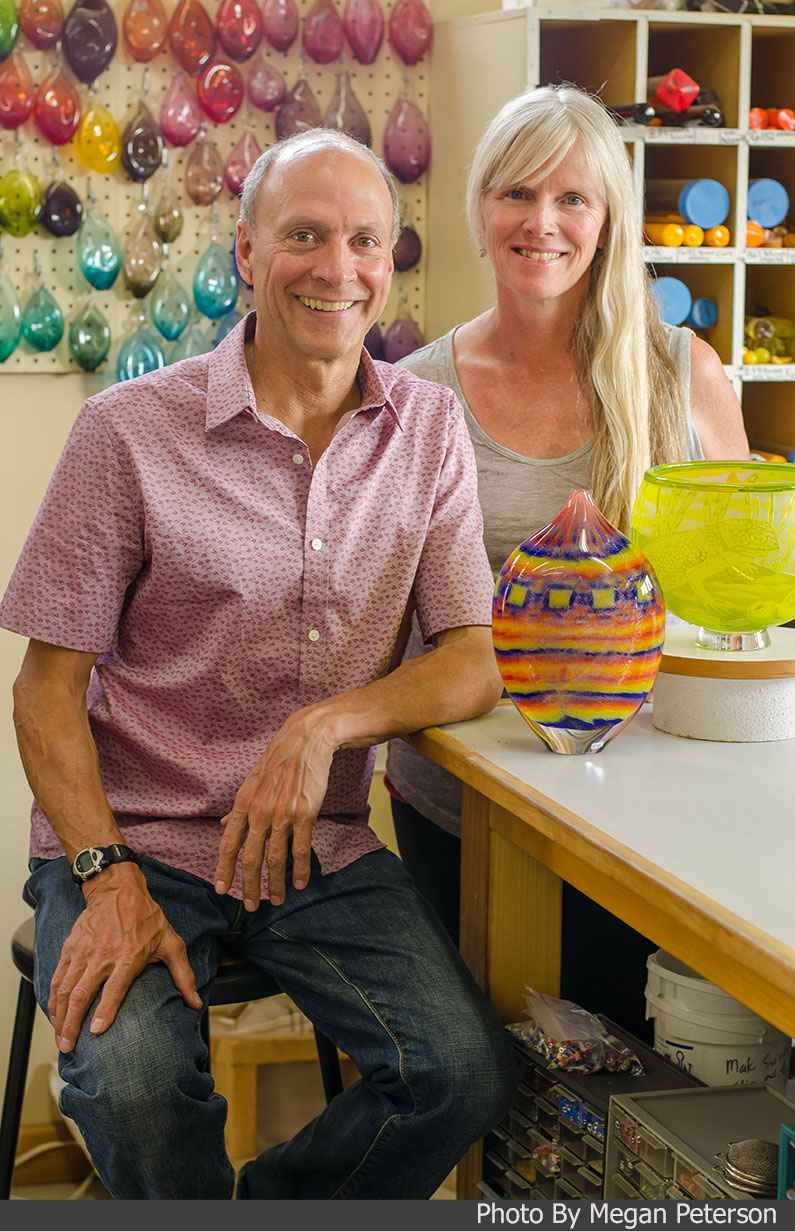Ralph Mossman/Mary Mullaney Works

Our uniquely detailed decorations are largely the result of our use of traditional cane techniques. These labor-intensive techniques are difficult to master, but result in patterns and decorations that are beautiful and sometimes mind-boggling as to how they were made. These techniques have traditionally been used to make paperweights, and marbles, but have also been used in a variety of glass objects for over 2000 years.
Basically, cane work involves building up layers of glass and stretching the mass out, resulting in a cane, which, when cut, reveals the miniaturized pattern of the original larger mass. We make cane which is meant to be viewed as a cross-section; these are called “murrinis”. And we also make cane that is meant to be viewed from the side, which results in a striped or twist or braid pattern. The twisted lines that resemble braids are called “latticino”. We originally thought this translated as “lattice”, but have since been corrected. The word is derived from “latte” to mean “milk-white” referring to the white colored stripes.
The time involved in making a single cane can range from ten minutes to close to an hour. Because some canes are made of other canes, the process can actually take place over many days. Each day one or more components of the final cane are made, and eventually they are put together to result in what is called a complex cane. Sometimes these resemble flowers, and are called “millefiore”, which translates to “a thousand flowers”. All these terms are from Venice, Italy, where many of the techniques were perfected in the twelfth and thirteenth centuries.
To build up a cane, we work from the center out, adding succeeding layers of colors or other pieces of already made cane. Sometimes the piece will be put in a mold to give it a star-shaped pattern before the next layer is added. There are many different ways of adding colors for various effects. After the mass is built up anywhere from the size of a thumb to the size of a coffee can, it is heated through completely to about 1600 degrees Fahrenheit and then stretched all at once to a length of 3 to 30 feet depending on how big it started out. To make twisted canes, we twist in opposite directions as the cane is being pulled. When the cane is cool, it is cut to length (button size for murrinis, and 1”-5” for latticino.
To use these pieces of cane in our work, we then reheat them again to about 1000 degrees Fahrenheit where they will fuse together and can be shaped and blown.
RALPH MOSSMAN
Artist Bio
Ralph Mossman was fascinated with glass blowing from the moment he watched unruly molten glass being shaped into a work of art. Mossman was a chemical engineering student from 1974-77 at Worcester Polytechnic Institute in Massachusetts when glass changed his path. He researched how to get involved with the medium and in 1978 enrolled in a glassblowing course taught by Fritz Dreisbach and Dale Chihuly at the Haystack Craft School in Deer Isle, Maine. In 1980 he studied glass at Penland Craft School in North Carolina. He received a B.A. in glassblowing from Hampshire College in Amherst, Massachusetts in 1981. After studying with numerous well-known and lesser-known glass artists, Mossman settled out west in the beautiful and isolated mountain town of Driggs, Idaho where he and his wife, glass artist Mary Mullaney, built their own studio in order to pursue their artistic visions.
His work is featured in numerous collections and galleries across the country, and has been featured twice in the “New Glass Review”.
Artist’s Statement
The digital vase series is inspired by my interest in digital imaging as well as a fascination with all the little dots in newspaper photos. I am also challenged by the abstract expressionist quest to create the illusion of depth in a two-dimensional surface, coupled with the reality of the thickness in the wall of a vessel. The analytical aspects of producing these pieces are an interesting counterpoint to the more intuitive process of glass blowing.
MARY MULLANEY
Artist Bio
Mary began blowing glass in 1984 at Southern CT State University under Peter Pelletieri and Chris Lubinski. Additional studies followed under Lino Tagliapietra and Lisabeth Sterling. A long time active participant in her local art community, Mary has also taught and lectured at a variety of venues including Horizons New England Craft School and The Studio at the Corning Museum of Glass. Her award winning work is featured in numerous art publications and has been exhibited in galleries throughout the US and internationally since 1988
Artist’s Statement
I direct a team to blow sizeable glass vessels into which I permanently carve imagery using a sandblaster and diamond engraving tools. The challenging hot glass techniques we use provide me with thin, transparent color layers which, when carved into, result in the myriad hues and shades of color which characterize my surface compositions. The finished piece is a highly personal, voluminous, sculptural narrative, which explores the undulating, curves in the form. I often make use of the seductive transparent and luminous qualities of glass as well as its ability to hold fine detail. Carved glass is as easily transformed into the crisp, geometric divisions of a dried seedpod as into the tissuey, ethereal and translucent petals of that same plant in full bloom.

